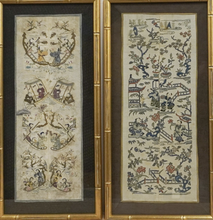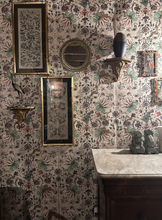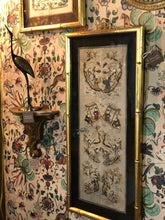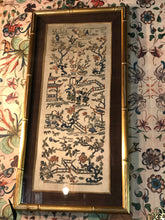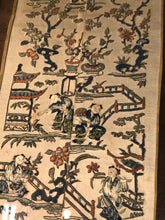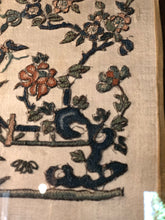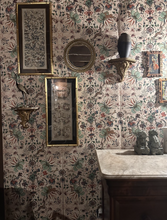
Chinese "Forbidden knot" embroidered-panel. Likely Qing Dynasty (1644-1911), likely produced in the Forbidden City in Beijing, China, for a noble or imperial client.
The hand is a touch difficult to decipher, but it seems to read:
'Bertha Grey Umpbly bought this in China on a trip in 1936. Most of the embroidery is in the "forbidden stich [sic]" which later was "outlawed -- or forbidden" as it is such fine work the women ruined their eyes.
'Syracus tray backing done 6/90
'Incu"
The Forbidden Stitch also known as the Chinese/Peking/Blind Knot, is an intricate embroidery technique, similar to the French Knot, in which the thread is wrapped at least twice around the needle before being pulled through the fabric to produce a loop of dimensional needlework. Its popularity in China hit its height during the Qing Dynasty (1644-1911), as through the Ming (1368-1644) and Qing dynasties, important men wore embroidered badges on their chests: the more elaborate the needlework, the more important the man, went the theory. With the collapse of the empire, however, and the notoriety of the stich, the technique fell out of favor.
Lurid tales tell of young girls losing their sight from such meticulously fine work have circulated ever since, but it seems the true reasons for the stitch's infamy, and name, were more complex than simple humanitarian concern for the eyes of young women. Many historians believe that the name "Forbidden stitch," did not in fact derive from a ban but, rather, from a place. The technique, it seems, was work that proceeded from the famed "Forbidden City," home of the Emperors of China from the 1400s until the 1900s: a place only those of great rank were permitted to set foot. The stitch, according to historians, was not forbidden because it was harming those who made it, but by demand that the use of such exquisite workmanship was the province of the emperor, alone, marking him out in all his glory by its use, and no one else was meant to use it. As an imperial status symbol, some say it was not even permitted to leave the Forbidden City, though the truth is that no evidence of any formal policy exists at all. However, as the stitch required such exquisite craftsmanship, time, and care to create (not to mention the cost of fabric, alone, at the time), its use was likely prohibitively expensive enough to ensure that the method was not, in fact, widespread -- particularly if the artisans, themselves, were indeed losing their ability to perform the stitch by undertaking it. (You can read more about the Forbidden Stitch here.)
After all, this is not to say that the seamstresses who served the emperor were not going slowly blind from working in ill-lit places, as the sad truth is that they may well have done, we simply don't know. But it seems that was not the reason for the original fame, or later infamy, of the stitch: it was that no one but the emperor, himself, was meant to own a piece of it.
Today, however, you can take home a piece of imperial grandeur to display on your very own walls! These pieces of breathtaking art were sourced by a tourist in China in 1936, as is inscribed on the back, proudly featuring this exquisite workmanship. This piece was certainly produced by hand, probably in the Forbidden City, and likely by a female artisan, as embroidery was largely a woman's province at the time. When the pieces were embroidered is difficult to say, though they must have been crafted prior to 1936, and it does seem the purchaser believed them to date to the Qing Dynasty, as the legend cited had the stitch outlawed after 1911. Such a date does seem likely as the use of the technique went into steep decline after that period, meaning that each antique panel was likely commissioned by someone (meaning to impress their princely peers!) of noble or even imperial family.
Framed. 24 x 11-1/8 in. (61 x 28.3 cm.)










